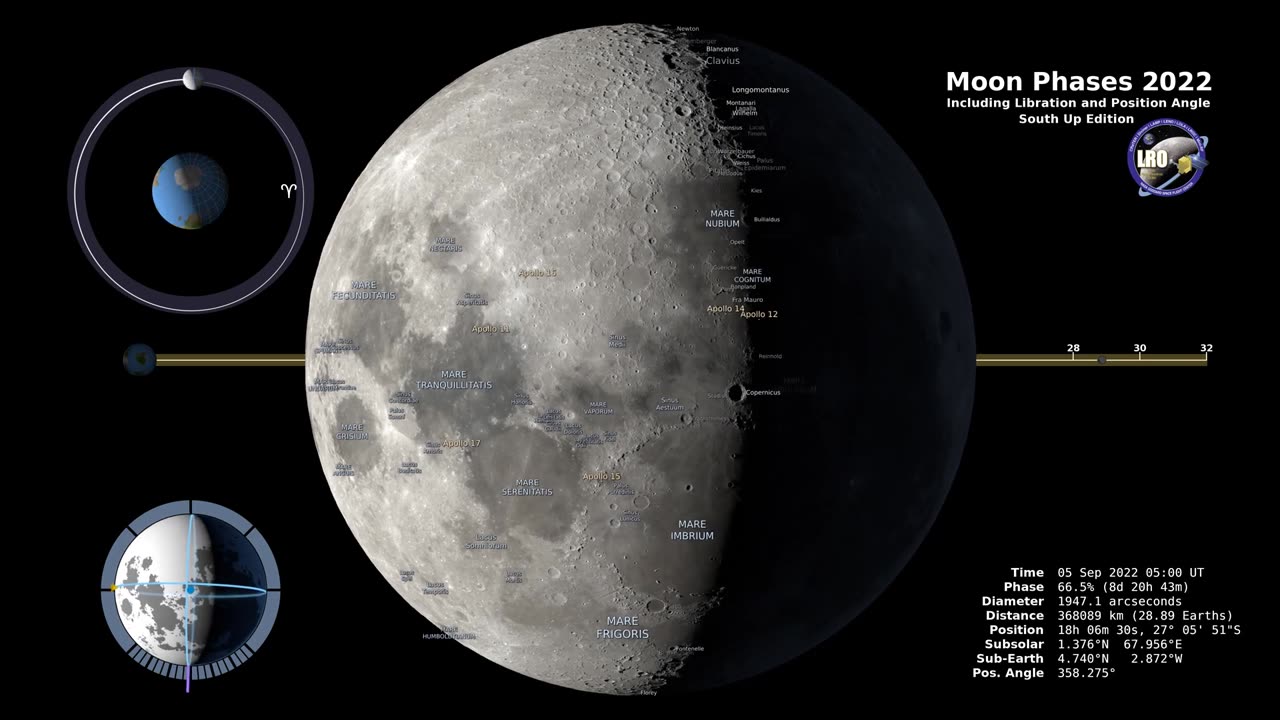Premium Only Content

Moon Phases 2022 – Southern Hemisphere – HD
the Moon phases follow the same general pattern as in the northern hemisphere, but there are some differences due to the perspective from which they are observed. Here's a basic overview of Moon phases in the southern hemisphere:
New Moon: During a New Moon, the Moon is positioned between the Earth and the Sun. In the southern hemisphere, the illuminated side of the Moon will be facing away from Earth, making it mostly invisible from southern latitudes. This is when the Moon is not visible or barely visible as a thin crescent shortly after sunset.
Waxing Crescent: As the Moon moves in its orbit, a small illuminated portion becomes visible from the southern hemisphere, forming a crescent shape that is "waxing" or increasing in illumination.
First Quarter: The First Quarter Moon appears when the Moon has completed about one-quarter of its orbit around the Earth. In the southern hemisphere, the right half of the Moon is illuminated, and it is visible in the evening sky.
Waxing Gibbous: The illuminated portion of the Moon continues to increase, leading to a phase known as the Waxing Gibbous Moon. This phase shows more than half but not yet all of the Moon's face as illuminated.
Full Moon: The Full Moon occurs when the Moon is on the opposite side of the Earth from the Sun. In the southern hemisphere, the entire face of the Moon that is visible from Earth is illuminated. It rises in the east as the Sun sets in the west and is visible throughout the night.
Waning Gibbous: Following the Full Moon, the illuminated portion gradually decreases, forming the Waning Gibbous Moon. This phase shows more than half but not yet all of the Moon's face as illuminated.
Last Quarter: The Last Quarter Moon appears when the Moon has completed about three-quarters of its orbit around the Earth. In the southern hemisphere, the left half of the Moon is illuminated, and it is visible in the morning sky.
Waning Crescent: As the Moon continues its orbit, the illuminated portion becomes smaller, forming a crescent shape that is "waning" or decreasing in illumination.
The cycle then repeats with the return of the New Moon. Keep in mind that the exact timing and visibility of Moon phases can vary based on your specific location within the southern hemispher
-
 LIVE
LIVE
The StoneZONE with Roger Stone
3 hours agoAnthony Fauci’s Brutal History Of Animal Torture Exposed! | The StoneZONE w/ Roger Stone
963 watching -
 LIVE
LIVE
megimu32
3 hours agoON THE SUBJECT: Will the Super Bowl Be WOKE??!
29 watching -
 1:18:26
1:18:26
Redacted News
4 hours agoBREAKING! USAID Created and Funded COVID-19 Virus and Bioweapons, RFK and Tulsi pass major hurdle
82.5K169 -
 50:54
50:54
Candace Show Podcast
5 hours agoBecoming Brigitte: Gaslighting The Public | Ep 1
134K147 -
 4:41:05
4:41:05
Right Side Broadcasting Network
9 hours agoLIVE: President Trump Holds Press Conference with Israeli PM Benjamin Netanyahu - 2/4/25
161K95 -
 LIVE
LIVE
Edge of Wonder
4 hours agoInception Is Real: How Ads Are Showing Up in Our Dreams
503 watching -
 54:50
54:50
LFA TV
8 hours agoThe Trade War Ends | TRUMPET DAILY 2.4.25 7pm
3.2K3 -
 LIVE
LIVE
Quite Frankly
8 hours ago"Capitol Hill Headlines & The Utah Case" ft Lauren Conlin, The Zells 2/4/25
1,220 watching -
 LIVE
LIVE
The Big Mig™
14 hours agoKiller of Men To Healer of Men Dr. Joe Bannon
2,065 watching -
 40:45
40:45
Chrissy Clark
2 hours agoUSAID’s Corruption, DC Airport Workers ARRESTED, & Ibram X Kendi Canceled?! I Underreported Stories
3.86K4